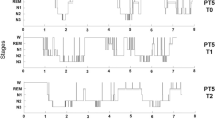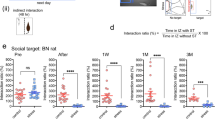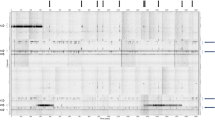Abstract
We examined whether fluoxetine treatment has persistent effects on electroencephalographic sleep after drug discontinuation in patients with recurrent major depression. Age-matched groups of 23 women were treated with interpersonal psychotherapy alone (IPT) or fluoxetine plus interpersonal psychotherapy (IPT + FLU). Sleep studies were conducted when patients were depressed, and again at remission, at least four weeks after fluoxetine discontinuation. The groups did not differ in depression ratings pre- to post-treatment. Significant group*time interaction effects were noted for REM sleep (p = .04) and slow wave sleep (p = .02). REM percentage and phasic REM activity increased in the IPT + FLU group but decreased in the IPT group. The effects of fluoxetine treatment on electroencephalographic sleep can be observed for at least four weeks after drug discontinuation and appear to represent both drug discontinuation and neuroadaptation effects.
Similar content being viewed by others
Log in or create a free account to read this content
Gain free access to this article, as well as selected content from this journal and more on nature.com
or
References
Armitage R, Emslie G, Rintelmann J . (1997b): The effect of fluoxetine on sleep EEG in childhood depression: A preliminary report. Neuropsychopharmacology 17: 241–245
Armitage R, Trivedi M, Rush AJ . (1995): Fluoxetine and oculomotor activity during sleep in depressed patients. Neuropsychopharmacology 12: 159–165
Armitage R, Yonkers K, Cole D, Rush AJ . (1997a): A multicenter, double-blind comparison of the effects of nefazodone and fluoxetine on sleep architecture and quality of sleep in depressed outpatients. J Clin Psychopharmacol 17: 161–168
Beasley CM, Sayler ME, Weiss AM, Potvin JH . (1992): Fluoxetine: Activating and sedating effects at multiple fixed doses. J Clin Psychopharmacol 12: 328–333
Beck AT, Ward CH, Mendelson M, Mock J, Erbaugh J . (1961): An inventory for measuring depression. Arch Gen Psychiatry 4: 561–571
Benca RM, Obermeyer WH, Thisted RA, Gillin JC . (1992): Sleep and psychiatric disorders: a meta-analysis. Arch Gen Psychiatry 49: 651–668
Bhatti T, Gillin JC, Golshan S, Clark C, Demodena A, Schlossr A, Stahl S, Kelsoe J, Rapaport M . (1995): The effect of a tryptophan-free amino acid drink on sleep and mood in normal controls. Sleep Res 24: 153
Bhatti T, Gillin JC, Seifritz E, Moore P, Clark C, Golshan S, Stahl S, Rapaport M, Kelsoe J . (1998): Effects of a tryptophan-free amino acid drink challenge on normal human sleep electroencephalogram and mood. Biol Psychiatry 43: 52–59
Buysse DJ, Frank E, Lowe KK, Cherry CR, Kupfer DJ . (1997): Electroencephalographic sleep correlates of episodes and vulnerability to recurrence in depression. Biol Psychiatry 41: 406–418
Buysse DJ, Hall M, Tu XM, Land S, Houck PR, Cherry CR, Kupfer DJ, Frank E . (1998): Latent structure of EEG sleep variables in depressed and control subjects: descriptions and clinical correlates. Psychiatry Res 79: 105–122
Buysse DJ, Kupfer DJ, Frank E, Monk TH, Ritenour A, Ehlers CL . (1992): Electroencephalographic sleep studies in depressed patients treated with psychotherapy. II. Longitudinal studies at baseline and recovery. Psychiatry Res 40: 27–40
Buysse DJ, Reynolds CF, Hoch CC, Houck PR, Kupfer DJ, Mazumdar S, Frank E . (1996): Longitudinal effects of nortriptyline on EEG sleep and the likelihood of recurrence in elderly depressed patients. Neuropsychopharmacology 14: 243–252
Buysse DJ, Reynolds CF, Monk TH, Berman SR, Kupfer DJ . (1989): The Pittsburgh Sleep Quality Index (PSQI): A new instrument for psychiatric research and practice. Psychiatry Res 28: 193–213
Dew MA, Reynolds CF, Houck PR, Hall M, Buysse DJ, Frank E, Kupfer DJ . (1997): Temporal profiles of the course of depression during treatment: Predictors of pathways toward recovery in the elderly. Arch Gen Psychiatry 54: 1016–1024
Doman J, Detka C, Hoffman T, Kesicki D, Monahan JP, Buysse DJ, Reynolds CF, Coble PA, Matzzie J, Kupfer DJ . (1995): Automating the sleep laboratory: Implementation and validation of digital recording and analysis. Intl J Med Inform 38: 277–290
Dorsey CM, Lukas SE, Cunningham SL . (1996): Fluoxetine-inducted sleep disturbance in depressed patients. Neuropsychopharmacology 14: 437–442
Dunleavy DLF, Brezinova V, Oswald I, MacLean AW, Tinker M . (1972): Changes during weeks in effects of tricyclic drugs on the human sleep brain. Br J Psychiatry 120: 663–672
Endicott J, Spitzer RL . (1978): A Diagnostic Interview. The schedule for affective disorders and schizophrenia. Arch Gen Psychiatry 35: 837–844
Endicott J, Spitzer RL, Fleiss JL, Cohen JL . (1976): The global assessment scale. A procedure for measuring overall severity of psychiatric disturbance. Arch Gen Psychiatry 33: 766–771
First M, Spitzer RL, Gibbon M, Williams JBW . (1995): Structured Clinical Interview for DSM-IV Axis I Disorders-Patient Edition (SCID-I/P). Version 2.0 ed. New York, NY, New York State Psychiatric Institute
Giles DE, Jarrett RB, Roffwarg HP, Rush AJ . (1987): Reduced rapid eye movement latency: A predictor of recurrence in depression. Neuropsychopharmacology 1: 33–39
Gillin JC, Rapaport M, Erman MK, Winokur A, Albala BJ . (1997): A comparison of nefazodone and fluoxetine on mood and on objective, subjective, and clinician-rated measures of sleep in depressed patients: A double-blind, 8-week clinical trial. J Clin Psychiatry 58: 185–192
Gillin JC, Wyatt RJ, Fram D . (1978): The relationship between changes in REM sleep and clinical improvement in depressed patients treated with amitriptyline. Psychopharmacology 59: 267–272
Hamilton M . (1967): Development of a rating scale for primary depressive illness. Br J Soc Clin Psychol 6: 278–296
Hartmann E, Cravens J . (1973): The effects of long term administration of psychotropic drugs on human sleep: III. The effects of amitriptyline. Psychopharmacology 33: 185–202
Hendrickse WA, Roffwarg HP, Grannemann BD, Orsulak PJ, Armitage R, Cain JW, Battaglia J, Debus JR, Rush AJ . (1994): The effects of fluoxetine on the polysomnogram of depressed outpatients: A pilot study. Neuropsychopharmacology 10: 85–91
Kerkhofs M, Rielaert C, de Maertelaer V, Linkowski P, Czarka M, Mendlewicz J . (1990): Fluoxetine in major depression: Efficacy, safety and effects on sleep polygraphic variables. Int Clin Psychopharmacol 5: 253–260
Klerman GL, Weissman MM, Rounsaville BJ, Chevron E . (1984): Interpersonal Psychotherapy of Depression. New York, NY, Academic Press, Basic Books Inc
Kupfer DJ, Frank E, McEachran AB, Grochocinski VJ . (1990): Delta sleep ratio: A biological correlate of early recurrence in unipolar affective disorder. Arch Gen Psychiatry 47: 1100–1105
Kupfer DJ, Pollock BG, Perel JM, Miewald JM, Grochocinski VJ, Ehlers CL . (1994): Effect of pulse loading with clomipramine on EEG sleep. Psychiatry Res 54: 161–175
Lauer CJ, Pollmacher T . (1992): On the issue of drug washout prior to polysomnographic studies in depressed patients. Neuropsychopharmacology 6: 11–16
McCann UD, Seiden LS, Rubin LJ, Ricaurte GA . (1997): Brain serotonin neurotoxicity and primary pulmonary hypertension from fenfluramine and dexfenfluramine. JAMA 278: 666–672
Mendelson WB . (1987): Pharmacology and neurotransmitters in sleep. In Anonymous, Human Sleep—Research and Clinical Care. New York, NY, Plenum Publishing Corporation, pp 33–79
Nicholson AN, Pascoe PA . (1988): Studies on the modulation of the sleep-wakefulness continuum in man by fluoxetine, a 5-HT uptake inhibitor. Neuropharmacology 27: 597–602
Raskin A, Schulterbrandt J, Reatig N, McKeon JJ . (1969): Replication of factors of psychopathology in interview, ward behavior and self-report ratings of hospitalized depressives. J Nerv Ment Dis 148: 87–98
Riemann D, Berger M . (1989): EEG sleep in depression and in remission and the REM sleep response to the cholinergic agonist RS 86. Neuropsychopharmacology 2: 145–152
Saletu B, Frey R, Krupka M, Anderer P, Grunberger J, See WR . (1991): Sleep laboratory studies on the single-dose effects of serotonin reuptake inhibitors paroxetine and fluoxetine on human sleep and awakening qualities. Sleep 14: 439–447
Satterlee WG, Faries D . (1995): The effects of fluoxetine on symptoms of insomia in depressed patients. Psychopharmacol Bull 31: 227–237
Schenck CH, Mahowald MW, Kim SW, O'Connor KA, Hurwitz TD . (1992): Prominent eye movements during NREM sleep and REM sleep behavior disorder associated with fluoxetine treatment of depression and obsessive-compulsive disorder. Sleep 15: 226–235
Schneider LS, Small GW, Hamilton SH, Bystritsky A, Nemeroff CB, Meyers BS, Fluoxetine Collaborative Study Group . (1997): Estrogen replacement and response to fluoxetine in a multicenter geriatric depression trial. Am J Ger Psychiatry 5: 97–106
Sharpley AL, Cowen PJ . (1995): Effect of pharmacologic treatments on the sleep of depressed patients. Biol Psychiatry 37: 85–98
Siegel JM . (1994): Brainstem mechanisms generating REM sleep. In Kryger MH, Roth T, Dement WC (eds), Principles and Practice of Sleep Medicine, 2nd ed. Philadelphia, PA, W.B. Saunders Company pp 125–144
Spitzer RL, Williams JB, Gibbon M, First MB . (1992): The Structured Clinical Interview for DSM-III-R (SCID). I: History, rationale, and description. Arch Gen Psychiatry 49: 624–629
Spitzer RL, Williams JBW, Gibbon M, First MB . (1988): Structured Clinical Interview for DSM-III-R: Patient Version (SCID-P, 6/01/88). New York, NY, Biometrics Research Department
Stokes PE . (1995): The potential role of excessive cortisol induced by HPA hyperfunction in the pathogenesis of depression. Eur Neuropsychopharmacol 5(suppl):77–82
Thase ME . (1998): Depression, sleep, and antidepressants. J Clin Psychiatry 59: 55–65
Thase ME, Fasiczka AL, Berman SR, Simons AD, Reynolds CF . (1998): Electroencephalographic sleep profiles before and after cognitive behavior therapy of depression. Arch Gen Psychiatry 55: 138–144
van Bemmel AL, Van den Hoofdakker RH, Beersma DG, Bouhuys AL . (1993): Changes in sleep polygraphic variables and clinical state in depressed patients during treatment with citalopram. Psychopharmacology 113: 225–230
Vgontzas AN, Kales A, Bixler EO, Manfredi RL . (1995): Usefulness of polysomnographic studies in the differential diagnosis of insomnia. Int J Neurosci 82: 47–60
Voderholzer U, Hornyak M, Thiel B, Huwig-Poppe C, Kiemen A, Konig A, Backhaus J, Riemann D, Berger M, Hohagen F . (1998): Impact of experimentally induced serotonin deficiency by tryptophan depletion on sleep EEG in healthy subjects. Neuropsychopharmacology 18: 112–124
von Bardeleben U, Steiger A, Gerken A, Holsboer F . (1989): Effects of fluoxetine upon pharmacoendocrine and sleep-EEG parameters in normal controls. Int Clin Psychopharmacol 4: 1–5
Winkelman J, Dorsey C, Cunningham S, Lukas S, Richardson G . (1992): Fluoxetine produces persistent rapid eye movements in non-rem sleep. Sleep Res 21: 78
Zajecka J, Tracy KA, Mitchell S . (1997): Discontinuation symptoms after treatment with serotonin reuptake inhibitors: A literature review. J Clin Psychiatry 58: 291–297
Acknowledgements
This work was supported by NIH grants MH-30915, MH-24652, MH-49115, AG-15138
Author information
Authors and Affiliations
Additional information
A preliminary version of these results was presented at the Association of Professional Sleep Societies annual meeting, 1997
Rights and permissions
About this article
Cite this article
Buysse, D., Kupfer, D., Cherry, C. et al. Effects of Prior Fluoxetine Treatment on EEG Sleep in Women with Recurrent Depression. Neuropsychopharmacol 21, 258–267 (1999). https://doi.org/10.1016/S0893-133X(99)00025-1
Received:
Revised:
Accepted:
Issue date:
DOI: https://doi.org/10.1016/S0893-133X(99)00025-1
Keywords
This article is cited by
-
Acute administration of the novel serotonin and noradrenaline reuptake inhibitor, S33005, markedly modifies sleep–wake cycle architecture in the rat
Psychopharmacology (2005)
-
State Markers of Depression in Sleep EEG: Dependency on Drug and Gender in Patients Treated with Tianeptine or Paroxetine
Neuropsychopharmacology (2003)



